
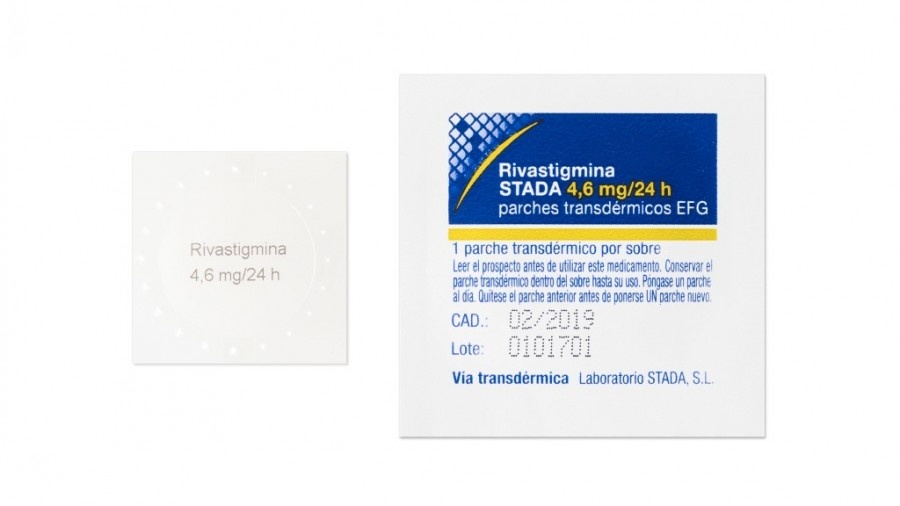
РІВАНЕКС 4,6 мг/24 год ТРАНСДЕРМАЛЬНІ ПЛАСТИРІ

Запитайте лікаря про рецепт на РІВАНЕКС 4,6 мг/24 год ТРАНСДЕРМАЛЬНІ ПЛАСТИРІ

Інструкція із застосування РІВАНЕКС 4,6 мг/24 год ТРАНСДЕРМАЛЬНІ ПЛАСТИРІ
Введення
Опис: інформація для пацієнта
Риванекс 4,6 мг/24години трансдермальні пластирі ЕФГ
Ривастигміна
Всім пацієнтам рекомендується уважно прочитати цю брошуру перед початком прийому цього лікарського засобу, оскільки вона містить важливу інформацію для вас.
- Збережіть цю брошуру, оскільки вам може знадобитися знову її прочитати.
- Якщо у вас виникли питання, проконсультуйтеся з вашим лікарем або фармацевтом.
- Цей лікарський засіб призначений тільки вам, і його не слід давати іншим людям, навіть якщо вони мають такі самі симптоми, оскільки це може їм нашкодити.
- Якщо ви відчуваєте побічні ефекти, проконсультуйтеся з вашим лікарем або фармацевтом, навіть якщо це побічні ефекти, які не наведені в цій брошурі. Див. розділ 4.
Зміст брошури
- Що таке Риванекс і для чого він використовується
- Що потрібно знати перед початком використання Риванексу
- Як використовувати Риванекс
- Можливі побічні ефекти
- Збереження Риванексу
- Зміст упаковки та додаткова інформація
1. Що таке Риванекс і для чого він використовується
Активним складником Риванекс-пластерів є ривастигміна.
Ривастигміна належить до групи інгібіторів холінестерази. У пацієнтів з деменцією Альцгеймера певні нервові клітини гинуть у мозку, що призводить до низьких рівнів нейротрансмітера ацетилхоліну (речовини, яка дозволяє нервовим клітинам спілкуватися між собою). Ривастигміна діє шляхом блокування ферментів, які руйнують ацетилхолін: ацетилхолінестерази та бутирилхолінестерази. Блокуючи ці ферменти, Риванекс дозволяє збільшити рівень ацетилхоліну в мозку, що допомагає зменшити симптоми хвороби Альцгеймера.
Риванекс використовується для лікування пацієнтів з деменцією Альцгеймера легкого та середнього ступеня, прогресивного захворювання мозку, яке впливає на пам'ять, інтелектуальні здібності та поведінку.
2. Що потрібно знати перед початком використання Риванексу
Не використовуйте Риванекс:
- якщо ви алергічні на ривастигміну або на будь-який інший складник цього лікарського засобу (перелічені в розділі 6).
- якщо ви раніше мали алергічну реакцію на подібний лікарський засіб (похідні карбамату).
- якщо у вас виникла шкірна реакція, яка поширюється за межі розміру пластира, якщо є місцеві реакції більш інтенсивні (наприклад, пухирі, збільшення запалення шкіри, набряк) і якщо немає покращення протягом 48 годин після зняття трансдермального пластира.
Якщо ви знаходитесь в одній з цих ситуацій, повідомте про це вашому лікареві і не використовуйте ривастигміну.
Попередження та обережність
Проконсультуйтеся з вашим лікарем перед початком використання цього лікарського засобу:
- якщо у вас є або раніше був нерегулярний серцевий ритм (пульс) або якщо він був повільним.
- якщо у вас є або раніше був активний виразковий захворювання шлунка.
- якщо у вас є або раніше були труднощі з сечовипусканням.
- якщо у вас є або раніше були судові напади.
- якщо у вас є або раніше була бронхіальна астма або важке респіраторне захворювання.
- якщо у вас є тремор.
- якщо у вас низька маса тіла.
- якщо у вас є шлунково-кишкові реакції, такі як нудота, блювота та діарея. Ви можете дегідратуватися (втратити велику кількість рідини), якщо блювота або діарея тривають тривалий час.
- якщо у вас є проблеми з печінкою (печінкова недостатність).
Якщо ви знаходитесь в одній з цих ситуацій, ваш лікар може вирішити, що необхідно проводити більш інтенсивний моніторинг під час лікування.
Якщо ви не використовували пластири протягом кількох днів, не ставте інший без попередньої консультації з вашим лікарем.
Діти та підлітки
Ривастигміна не повинна використовуватися в дитячій популяції для лікування хвороби Альцгеймера.
Інші лікарські засоби та Риванекс
Повідомте про це вашому лікареві або фармацевту, якщо ви використовуєте, нещодавно використовували або можете використовувати будь-який інший лікарський засіб.
Ривастигміна може взаємодіяти з антихолінергічними лікарськими засобами, деякі з яких використовуються для полегшення шлунково-кишкових спазмів (наприклад, дцикломін), для лікування хвороби Паркінсона (наприклад, амантадин) або для профілактики рухової хвороби (наприклад, дифенгідрамін, скополамін або меклізин).
Цей лікарський засіб не слід приймати одночасно з метоклопрамідом (лікарським засобом, який використовується для полегшення або профілактики нудоти та блювоти). Прийом обох лікарських засобів одночасно може призвести до проблем, таких як ригідність кінцівок та тремор рук.
У разі проведення хірургічної операції під час лікування ривастигміною повідомте про це вашому лікареві, оскільки це може посилити дію деяких м'язових релаксантів анестезії.
З обережністю слід використовувати цей лікарський засіб разом з бета-блокаторами (лікарськими засобами, такими як атенолол, які використовуються для лікування гіпертонії, ангіни та інших серцевих захворювань). Прийом обох лікарських засобів одночасно може призвести до ускладнень, таких як зниження частоти серцевих скорочень (брадикардія), яке може призвести до втрати свідомості.
Використання Риванексу з їжею, напоями та алкоголем
Цей лікарський засіб можна використовувати з їжею, напоями та алкоголем.
Вагітність, лактація та фертильність
Якщо ви вагітні або годуєте грудьми, вважаєте, що можете бути вагітною або плануєте вагітність, проконсультуйтеся з вашим лікарем або фармацевтом перед прийняттям цього лікарського засобу.
Якщо ви вагітні, необхідно оцінити користь від використання ривастигміни порівняно з можливими побічними ефектами для плода. Не слід використовувати цей лікарський засіб під час вагітності, якщо це не абсолютно необхідно.
Не слід годувати грудьми під час лікування ривастигміною.
Відповідальність за керування транспортними засобами та використання машин
Ваша хвороба може вплинути на вашу здатність керувати транспортними засобами чи використовувати машини, і ви не повинні виконувати ці дії, якщо ваш лікар не підтвердить, що це безпечно.
Риванекс-пластири можуть викликати головокружіння та сонливість, особливо на початку лікування або при збільшенні дози. Якщо ви відчуваєте ці ефекти, не слід керувати транспортними засобами чи використовувати машини.
3. Як приймати Риванекс
Слідуйте точно інструкціям щодо прийому цього лікарського засобу, які вказані вашим лікарем. У разі сумнівів проконсультуйтеся з вашим лікарем або фармацевтом.
Важливо:
- Зніміть попередній пластир перед тим, як поставити новий.
- Тільки один пластир на добу.
- Не розрізайте пластир на частини.
- Тримайте пластир тісно приєднаним до шкіри пальцями протягом мінімум 30 секунд.
Як розпочати лікування
Ваш лікар призначить вам найбільш підходящу дозу ривастигміни.
- Зазвичай лікування починається з ривастигміни 4,6 мг/24години.
- Рекомендована добова доза становить ривастигміну 9,5 мг/24години. Якщо ця доза добре переноситься, ваш лікар може вирішити збільшити її до 13,3 мг/24години.
- Носіть тільки один пластир ривастигміни одночасно і заміняйте пластир на новий через 24 години.
Під час лікування ваш лікар може коригувати дозу залежно від ваших індивідуальних потреб.
Якщо ви не використовували пластири протягом трьох днів, не ставте інший без попередньої консультації з вашим лікарем. Лікування пластиром можна відновити на тій самій дозі, якщо перерва не тривала більше трьох днів. В іншому випадку ваш лікар призначить вам відновлення лікування ривастигміною 4,6 мг/24години.
Де розмістити пластир Риванекс
- Перед тим, як поставити пластир, переконайтеся, що шкіра чиста, суха та без волосся, без пудри, олії, крему або лосьйону, які можуть перешкоджати приєднанню пластира до шкіри, без порізів, червоних плям або подразнення.
- Обережно зніміть будь-який пластир, який ви носите, перед тим, як поставити новий. Ношення кількох пластирів на вашому тілі може призвести до надмірної кількості цього лікарського засобу та бути потенційно небезпечним.
- Поставтетільки одинпластир на добу в однійз можливих зон, як показано на наступних схемах:
- Верхня ліва або верхня права частина руки
- Верхня ліва або верхня права частина грудної клітки (у жінок, уникати молочних залоз)
- Верхня ліва або верхня права частина спини
- Нижня ліва або нижня права частина спини
Кожні 24 години зніміть попередній пластир перед тим, як поставити новий пластир водній з наступних зон.
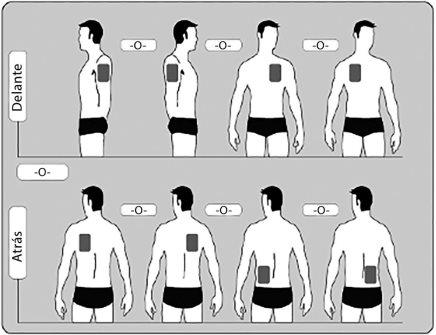
Кожного разу, коли ви змінюєте пластир, вам потрібно зняти попередній пластир перед тим, як поставити новий пластир в іншому місці шкіри (наприклад, один день на правій стороні тіла, а наступного дня на лівій стороні; або один день на верхній частині тіла, а наступного дня на нижній частині). Чекайте принаймні 14 днів, перш ніж знову поставити новий пластир точно в тій самій зоні шкіри.
Як застосовувати пластири Риванекс
Пластири Риванекс виготовлені з тонкого та непрозорого пластику та прикріплюються до шкіри. Кожен пластир знаходиться в окремому захисному пакеті. Не відкривайте пакет та не виймайте пластир, доки не вирішите його поставити.
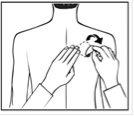
Обережно зніміть існуючий пластир перед тим, як поставити новий.
Пацієнти, які починають лікування вперше, та пацієнти, які відновлюють лікування Риванексом після перерви в лікуванні, повинні розпочати з другої схеми.

Кожен пластир знаходиться в окремому захисному пакеті. Відкривайте пакет тільки перед тим, як поставити пластир. Розрізайте пакет уздовж пунктирної лінії ножицями та виймайте пластир з пакету.
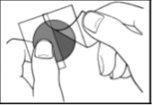
Охоронна плівка покриває клеїв частину пластира. Зніміть першу плівку з пластира, не торкаючись пальцями клеїв частини.
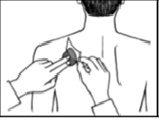
Помістіть клеїв частину пластира на верхню або нижню частину спини чи на верхню частину руки або грудної клітки, а потім зніміть другу плівку з охоронної плівки.
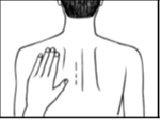
Тримайте пластир тісно приєднаним до шкіри пальцями протягом мінімум 30 секунд та переконайтеся, що краї пластира добре приклеєні.
Якщо це допоможе, ви можете написати на пластирі, наприклад, день тижня, тонким округлим олівцем.
Ви повинні носити пластир безперервно до моменту заміни його на новий. Коли ви поставите новий пластир, ви можете спробувати різні зони, щоб знайти ті, які будуть для вас найбільш зручними та де одяг не торкнеться пластира.
Як зняти пластири Риванекс
Аккуратно потягніть за один з країв пластира, щоб повільно зняти його зі шкіри. Якщо залишилися клеїві залишки на шкірі, змочіть цю область теплою водою та мильним розчином або використайте дитячу олію, щоб видалити їх. Не слід використовувати спирт чи інші розчинники (наприклад, засоби для видалення лаку для нігтів).
Після зняття пластира руки потрібно вимити мильним розчином або водою. У разі контакту з очима або якщо очі червоніють після маніпуляцій з пластиром, потрібно негайно промити їх великою кількістю води та звернутися за медичною допомогою, якщо симптоми не зникнуть.
Чи можна носити пластири Риванекс під час купання, плавання або опромінення сонцем?
- Купання, плавання чи душ не повинні впливати на пластир. Переконайтеся, що він не відстає частково під час цих дій.
- Не піддавайте пластир дії зовнішніх джерел тепла (наприклад, надмірного сонячного світла, сауни, солярію) протягом тривалих періодів.
Що робити, якщо пластир відстає
Якщо пластир відстає, поставте новий на решту дня та замініть його на наступний день о звичайній годині.
Коли та як довго потрібно носити пластири Риванекс
- Щоб отримати користь від лікування, потрібно ставити новий пластир кожного дня, бажано о одній і тій самій годині.
- Носіть тільки один пластир Риванекс одночасно та заміняйте пластир на новий через 24 години.
Якщо ви прийняли більше Риванексу, ніж потрібно
Якщо ви випадково поставили більше одного пластира, зніміть всі пластири зі шкіри, проконсультуйтеся з вашим лікарем або фармацевтом або зверніться до Токсикологічної служби, телефон: 91 562 04 20, вказавши назву лікарського засобу. Деякі люди, які випадково прийняли надмірну кількість ривастигміни, мали нудоту, блювоту, діарею, підвищений тиск та галюцинації. Можуть також виникнути сповільнення серцевого ритму та втрати свідомості.
Якщо ви забули використовувати Риванекс
Якщо ви зрозуміли, що забули поставити пластир, поставте його негайно. На наступний день поставте наступний пластир о звичайній годині. Не ставте два пластири, щоб компенсувати пропущений.
Якщо ви припинили лікування Риванексом
Повідомте про це вашому лікареві або фармацевту.
Якщо у вас є інші питання щодо використання цього лікарського засобу, проконсультуйтеся з вашим лікарем або фармацевтом.
4. Можливі побічні ефекти
Як і всі лікарські засоби, цей лікарський засіб може викликати побічні ефекти, хоча не всі люди їх відчувають.
Ви можете відчувати побічні ефекти частіше на початку лікування або при збільшенні дози. Зазвичай побічні ефекти повільно зникають, коли ваш організм звикає до лікарського засобу.
Якщо ви відчуваєте будь-який із наступних побічних ефектів, які можуть бути серйозними, зніміть пластир та негайно проконсультуйтеся з вашим лікарем:
Часті (можуть впливати до 1 особи з 10)
- Втрата апетиту.
- Головокружіння.
- Стан агітації чи оніміння.
- Неможливість утримувати сечу (нездатність належним чином контролювати сечовипускання).
Нечасті (можуть впливати до 1 особи з 100)
- Проблеми з серцевим ритмом, такі як сповільнений серцевий ритм.
- Галюцинації (сприйняття речей, які насправді не існують)
- Виразкова хвороба шлунка.
- Дегідратування (втрата великої кількості рідини).
- Гіперактивність (високий рівень активності, неспокій).
- Агресивність.
Рідкі (можуть впливати до 1 особи з 1000)
- Падіння.
Дуже рідкі (можуть впливати до 1 особи з 10 000)
- Ригідність рук та ніг.
- Тремор рук.
Частота невідома (не може бути оцінена з наявних даних)
- Алергічна реакція в місці застосування пластира, така як пухирі або запалення шкіри.
- Погіршення симптомів хвороби Паркінсона – таких як тремор, ригідність та труднощі руху.
- Запалення підшлункової залози – симптоми включають сильний біль у верхній частині живота, часто разом з нудотою чи блювотою.
- Швидкий або нерегулярний серцевий ритм.
- Високий кров'яний тиск
- Конвульсії (удари).
- Порушення функції печінки (жовтіння шкіри, жовте забарвлення білків очей, аномальне потемніння сечі чи нудота без пояснення, блювота, втома та втрата апетиту).
- Зміни в аналізах, які показують функцію вашої печінки.
- Стан неспокою.
- Кошмари
- Синдром Піза (стан, який включає мимовільне скорочення м'язів та аномальне нахилання тіла та голови в бік).
Якщо ви відчуваєте будь-який із перелічених вище побічних ефектів, зніміть пластир та негайно проконсультуйтеся з вашим лікарем.
Інші побічні ефекти, які були зазначені при застосуванні ривастигміни у вигляді капсул або розводжуваної таблетки, і які можуть виникнути при застосуванні пластирів:
Часті (можуть впливати до 1 особи з 10)
- Надмірна слина.
- Втрата апетиту
- Стан агітації
- Загальний стан нездоров'я.
- Тремор або стан спантеличення.
- Збільшення потовиділення.
Нечасті (можуть впливати до 1 особи з 100)
- Нерегулярний серцевий ритм (наприклад, швидкий серцевий ритм)
- Труднощі зі сном
- Нечасті випадкові падіння
Рідкі (можуть впливати до 1 особи з 1000)
- Виразкова хвороба кишечника.
- Конвульсії (удари)
- Біль у грудній клітці – ймовірно, через спазм у серці.
Дуже рідкі (можуть впливати до 1 особи з 10 000)
- Кровотеча в шлунково-кишковому тракті – проявляється як кров у фекаліях або при блювоті.
- Високий кров'яний тиск
- Запалення підшлункової залози – симптоми включають сильний біль у верхній частині живота, часто разом з нудотою чи блювотою
- Кровотеча в шлунково-кишковому тракті – проявляється як кров у фекаліях або при блювоті
- Галюцинації (сприйняття речей, які насправді не існують)
- Деякі люди, які були сильно нудотними (блювали), мали розрив частини травного тракту, який з'єднує рот з шлунком (есофагус)
Звітність про побічні ефекти
Якщо ви відчуваєте будь-який побічний ефект, проконсультуйтеся з вашим лікарем або фармацевтом, навіть якщо це можливі побічні ефекти, які не наведені в цій брошурі. Ви також можете повідомити про них безпосередньо через Українську систему моніторингу безпеки лікарських засобів, https://www.notificaRAM.es. Надсилаючи повідомлення про побічні ефекти, ви можете допомогти надати більше інформації про безпеку цього лікарського засобу.
5. Зберігання Ріванексу
Цей лікарський засіб не потребує особливої температури зберігання. Тримати в оригінальній упаковці, щоб захистити від світла. Зберігати трансдермальну плівку всередині пакету до її використання.
Тримати цей лікарський засіб поза зором і поза досягненням дітей.
Не використовувати цей лікарський засіб після закінчення терміну придатності, зазначеного на коробці та пакеті. Термін придатності - останній день місяця, зазначеного на упаковці.
Не використовувати жоден пластр, якщо ви помітили, що він пошкоджений або має ознаки порушення.
Після зняття пластиру скласти його вдвічі з липкою стороною всередину та натиснути. Після того, як ви покладете його в оригінальний пакет, при видаленні пластиру переконайтеся, що він знаходиться поза зором дітей. Після зняття пластиру не торкайтеся очей, а руки мийте добріше з водою та мильним засобом.
Лікарські засоби не повинні викидатися у водопровідні труби чи сміттєві контейнери. Відкладайте упаковки та лікарські засоби, які вам не потрібні, у спеціальний пункт збору в аптеці. У разі сумнівів запитайте у вашого фармацевта, як позбутися упаковок та лікарських засобів, які вам вже не потрібні. Таким чином, ви допоможете захистити довкілля.
6. Зміст упаковки та додаткова інформація
Склад Ріванексу
Активний інгредієнт - ривастигміна. Кожен пластр виділяє 4,6 мг ривастигміни протягом 24 годин, має площу 5 см² та містить 9 мг ривастигміни.
Інші складові частини: зовнішня плівка [поліестерова плівка, поліестерова плівка з покриттям силікону, поліестерова плівка з покриттям фтору], адгезивна матриця [акриловий адгезив (DURO-TAK87-235A), акрилатний кополімер (PLASTOID B) та етилацетат], адгезивна плівка [силіконовий адгезив (BIO-PSA 7-4302)] та друкарська фарба.
Вигляд продукту та вміст упаковки
Ріванекс 4,6 мг/24 години трансдермальні пластири випускаються у вигляді трансдермальної плівки, що складається з трьох шарів. Зовнішній шар має округлу форму. Кожен пакет містить один трансдермальний пластр.
Ріванекс 4,6 мг/24 години трансдермальні пластири випускаються в упаковках, що містять 30 або 60 пакетів. Можливо, що тільки деякі розміри упаковок будуть реалізовані.
Власник дозволу на реалізацію та відповідальна особа за виробництво
Власник дозволу на реалізацію
NEURAXPHARM SPAIN, S.L.U.
Avda. Barcelona, 69
08970 Sant Joan Despí - (Barcelona)
Іспанія
Відповідальна особа за виробництво
Eurofins PHAST GmbH
Kardinal-Wendel-Strasse 16,
66424 Homburg,
Німеччина
Дата останнього перегляду цього посібника: Січень 2025
Інші джерела інформації
Детальна та оновлена інформація про цей лікарський засіб доступна на сайті Іспанського агентства лікарських засобів та медичних продуктів (AEMPS) http://www.aemps.gob.es/
- Країна реєстрації
- Діючі речовини
- Потрібен рецептТак
- Виробник
- Інформація є довідковою і не є медичною порадою. Перед прийомом будь-яких препаратів обов'язково проконсультуйтеся з лікарем. Oladoctor не несе відповідальності за медичні рішення, прийняті на основі цього контенту.
- Альтернативи до РІВАНЕКС 4,6 мг/24 год ТРАНСДЕРМАЛЬНІ ПЛАСТИРІФорма випуску: ТРАНСДЕРМАЛЬНИЙ ПЛАСТИР, 13,3 мг/24 годДіючі речовини: rivastigmineВиробник: Esteve Pharmaceuticals S.A.Потрібен рецептФорма випуску: ТРАНСДЕРМАЛЬНИЙ ПЛАСТИР, 4,6 мг/24 годДіючі речовини: rivastigmineВиробник: Esteve Pharmaceuticals S.A.Потрібен рецептФорма випуску: ТРАНСДЕРМАЛЬНИЙ ПЛАСТИР, 9,5 мг/24 годДіючі речовини: rivastigmineВиробник: Esteve Pharmaceuticals S.A.Потрібен рецепт
Аналоги РІВАНЕКС 4,6 мг/24 год ТРАНСДЕРМАЛЬНІ ПЛАСТИРІ в інших країнах
Найкращі аналоги з тією самою діючою речовиною та терапевтичним ефектом.
Аналог РІВАНЕКС 4,6 мг/24 год ТРАНСДЕРМАЛЬНІ ПЛАСТИРІ у Польща
Аналог РІВАНЕКС 4,6 мг/24 год ТРАНСДЕРМАЛЬНІ ПЛАСТИРІ у Україна
Лікарі онлайн щодо РІВАНЕКС 4,6 мг/24 год ТРАНСДЕРМАЛЬНІ ПЛАСТИРІ
Консультація щодо дозування, побічних ефектів, взаємодій, протипоказань та поновлення рецепта на РІВАНЕКС 4,6 мг/24 год ТРАНСДЕРМАЛЬНІ ПЛАСТИРІ – за рішенням лікаря та згідно з місцевими правилами.











